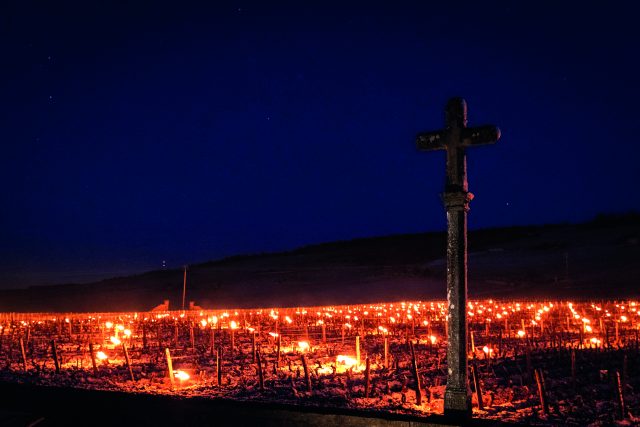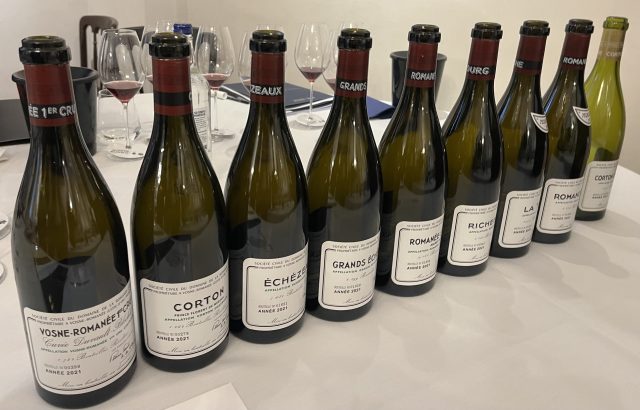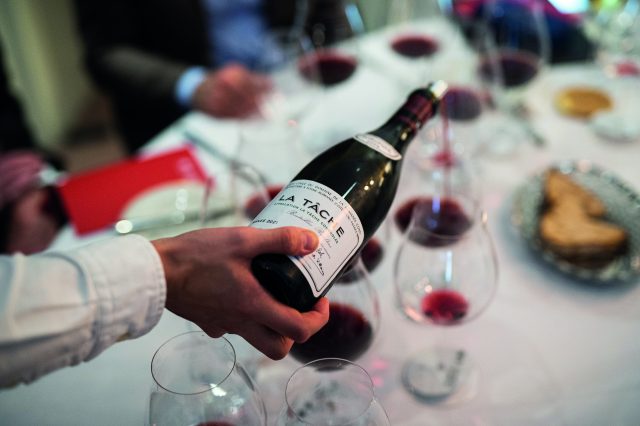This website uses cookies so that we can provide you with the best user experience possible. Cookie information is stored in your browser and performs functions such as recognising you when you return to our website and helping our team to understand which sections of the website you find most interesting and useful.
Domaine de la Romanée-Conti 2021: elegance in the face of adversity
The 2021 vintage saw Burgundy ravaged by devastating spring frosts, but how did the wines from its most prestigious estate hold up? Louis Thomas reports.

The domaine’s co-directors Perrine Fenale and Bertrand de Villaine were present at the offices of merchant Corney & Barrow for the en primeur showcase of its 2021s to a cohort of assembled wine trade professionals.
Corney & Barrow managing director Adam Brett-Smith revealed that the tasting was not a sure thing: “We had a debate with the domaine over whether to do anything given the pathetic size of the vintage, but we decided we must.”
After a mild winter, the decisive blow was inflicted on the nights of 6, 7 and 8 April, when a sudden cold snap caused the mercury to drop to -8°C in some parts of the estate. Snowfall on 7 April followed by another frost the next night wrecked the buds. This disaster confounded the received wisdom that lower lying vineyards are more vulnerable to frost (as cool, moist air settles), as higher areas, such as La Tâche in Vosne-Romanée, were more acutely affected. A warmer, but often wet, summer did little to assuage fears of low yields, especially when the damage had already been dealt.
While “pathetic” is a strong word, the figures do indeed make for grim reading. The frost cost the vineyards dearly. The area of Vosne lost around half of its crop, and Corton and Montrachet both lost a staggering 90%. Harvesting in Corton, which took place from 26 to 27 September, revealed a yield per hectare of 5 hectolitres (24.6hl/ha in 2020), and La Tâche’s wasn’t much better at 8.6hl/ha (29.7hl/ha in 2020). The saving grace was that weather conditions ahead of picking were favourable.
Quality over quantity
But Brett-Smith suggested that the immense losses made what was left all the more precious: “Wines born of difficult vintages sometimes have beauty in direct proportion to the difficulty.”
The night before, Corney & Barrow had undertaken a comparative tasting of the 2021s against the wines of 2008, a vintage which Brett-Smith said “makes 2021 look easy!”
Fenale was similarly stoic, suggesting that there is no point crying over grapes that could have been: “Rather than feeling sorry for the lack of quantity, we feel blessed that the vines were able to ripen their fruit.”
By the end of the growing season, in late September and early October, potential alcohol levels were between 13.5% and 14%.
In the cellar, after careful sorting of the grapes, maître de chai Alexandre Bernier vinified whole bunches, though with a shorter maceration period in order to reduce the risk of extracting ‘green’, or vegetal flavours.
Because of the relatively delicate nature of the wines, a shorter period of barrel maturation was opted for in order not to impart too much oak character. The wines then spent a stint in steel prior to bottling, which took place between December 2022 and April 2023.

“When I first tasted the Vosne-Romanée 1er Cru Cuvée Duvault-Blochet, I thought it was too good,” opined Brett-Smith, noting surprising concentration for such a cool year.
Following this, the Corton, or what little there was, offered a red fruit-forward perfume that offered, in De Villaine’s view, “a touch of elegance”. Indeed, “elegance” would very much be the key descriptor for many of the wines tasted – a consequence of a cool growing season and a shorter maceration.
Fenale said of the Échézaux, which was the last parcel to be picked (harvesting concluded on 2 October), that what it lacked in concentration, it made up for with its “wonderful structure”. More structured still was the Grands Échézaux, which, despite its youth, offered tannins with slight grip, but that were by no means green. The Grands Échézaux vineyard itself also enjoyed the most impressive yields of 2021, producing 21.6hl/ha.
The Romanée-St-Vivant is, in the words of De Villaine, a “fist in a velvet glove…very traditional, with a lot of energy and strength”.
Following this, the “elegance” of the Richebourg was emphasised, with this tasting marking the first time in several years that it had been tasted after the Romanée-St-Vivant, despite the latter’s power.
It was even suggested that with wines of this quality, they can transcend the problems of the growing season.
“Romanée-Conti is another universe,” according to De Villaine. “Even in a difficult vintage everything is always racy and elegant. It is not an explosive show off, but it feels solid in the mouth – you have so much material.”
A similar view was expressed of the Corton-Charlemagne, the domaine’s third vintage of this white wine vinified from the En Charlemagne and Le Charlemagne plots. The Chardonnay grapes that survived the frosts (the yield for 2021 was 4.8hl/ha, less than a tenth of what it was in 2020) ultimately created a wine which Brett-Smith’s tasting note summarised as “both zesty and creamily lush”.
Of the nine wines tasted, the one that seemed to unanimously be the attendees’ favourite on the day was La Tâche (£1,470 for one bottle in bond), which Fenale described as standing out due to its “serenity”. Perhaps, as Brett-Smith suggested, its appeal was directly related to its difficult growing season.

De Villaine noted that, in spite of its youth, La Tâche was showing particularly well already: “It is perfectly gorgeous now. If you take a 2019 La Tâche, for example, it needs to be kept for some time as it’s strong and powerful. This wine [2021] is more elegant.”
Corney & Barrow’s drinking date guidlines suggest that La Tâche will be in its prime between 2029 and 2040.
“We thought the 2019s would be very easy to drink young – we were surprised,” Fenale added, before clarifying that the domaine does not “aim” to create wines for early drinking: “They have their own lives.”
Asked about ageing potential, Fenale quipped: “There is not a lot of wine to wait for!”
De Villaine suggested that making wines for youthful drinking was “not the spirit of the domaine”, and commented: “What is important is that wines like the Échézaux, for example, can be drunk young, but still have the capacity to travel in the future.”
Corney & Barrow’s estimates for the drinking window generally stretch into the 2030s, with the Montrachet (of which just four barrels were made from 2021’s crop) being predicted to remain outstanding well into the 2040s.
Scarcity certainly adds value, though the price the wine commands is not proportional to how little there is. Corney & Barrow’s brochure for the significantly more plentiful 2020 vintage shows the difference in prices the comparatively rare 2021 bottles are commanding. For example, at the time, a bottle in bond of 2020 Romanée-Conti was £3,870, for the 2021 vintage it is £4,250. Likewise, at the comparatively lower end with Corton, a case of three bottles of 2020 in bond was £1,185, whereas for the 2021 it is £1,305 – notable, if not monumental increases.
It will certainly be interesting to see how the release of the 2021 vintage will impact Domaine de la Romanée-Conti’s position in the Liv-ex Power 100 – in 2023 the estate fell to 67th place, having been second in 2019.
Frosty reception
Although the candles used to warm the grapes on frosty nights across Burgundy made for beautiful images, this traditional anti-frost technique carries a number of disadvantages, especially due to the labour required to keep them burning overnight, and their effectiveness is questionable. For Domaine de la Romanée-Conti, its use of candles in 2021 was the “first time” that such a decision had been made, according to De Villaine.
However, it might have also been the last time too.
“We have some stores of candles that we will never use,” Fenale revealed.
Domaine de la Romanée-Conti has also previously invested in a windmill to ventilate the vines, thus theoretically reducing the risk of frost. However, it was deemed “impractical” due to the noise disturbance it caused residents, and because, according to De Villaine, without added heaters (and the extra energy expenditure that come with them), it would just churn cold air through the vineyard, potentially worsening the problem.
It was also suggested that trying to prevent these climatic hazards was antithetical to the philosophy and identity of Domaine de la Romanée-Conti.
“Are we still going to be making Romanée-Conti in 10 years time if we have heating wires through the vines,” De Villaine exclaimed, “or are we going to skip vintages?” The answer to both suggestions is a resolute ‘no’. Earlier, he had suggested that 2021 was an anomalous year, and that by and large a warmer growing season due to climate change has made vintages “easier” in recent years.
Fenale argued that Domaine de la Romanée-Conti, which adheres to organic viticultural practices, has to respect the cards it is dealt each growing season: “Our decision is to fight the battles when we come to them, but not to try to win the war.”
De Villaine echoed this sentiment.
“We don’t want to erase the influence of nature, or of the terroir we have,” he said. “We have a small production, we don’t have the right to modify what happens. No matter what you do, nature always wins.”

